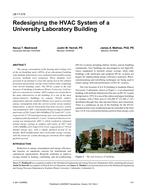Description
The energy consumption of the heating and cooling coils of the air-handling units (AHUs) of an educational building with multiple laboratories was evaluated and suitable energy recovery methods were proposed. These methods were assessed in an attempt to reuse the energy lost in the exhaust airstream and promote energy conservation while complying with current building codes. The HVAC system of the Life Sciences II building of Southern Illinois University–Carbondale is a constant-air-volume, 100% outdoor air system due to the many laboratories in the building. It is one of the most energy-intensive buildings on campus. Hourly surface temperature data for southern Illinois were used to correlate energy consumption from the current system versus outdoor temperature. A glycol runaround loop heat recovery system was designed forAHU1 and annual energy savings in summer and winter of 208.5 and 1360.9MMBtu(220.3 and 1437.1 GJ), respectively(17.8%ofannualenergy use),wereestimated with asimple paybackperiod of 5.1 years.Areturn air heat recovery system was designed for AHU 3, which resulted in estimated annual energy savings in summer and winter of 365.7 and 1399.4 MMBtu (385.9 and 1476.5 GJ), respectively (17.9% of annual energy use), with a simple payback period of six months. Both modifications show noticeable energy savings, with the return air system showing an extremely short simple payback period.
Citation: ASHRAE Transactions, vol. 123, pt. 2
Product Details
- Published:
- 2017
- Number of Pages:
- 12
- Units of Measure:
- Dual
- File Size:
- 1 file , 2.9 MB
- Product Code(s):
- D-LB-17-018




